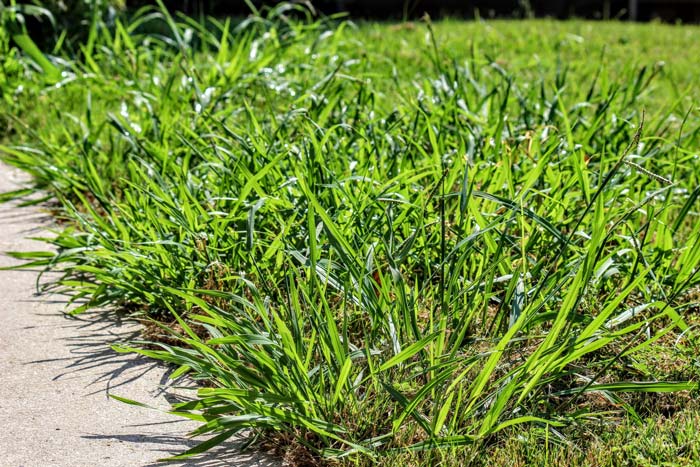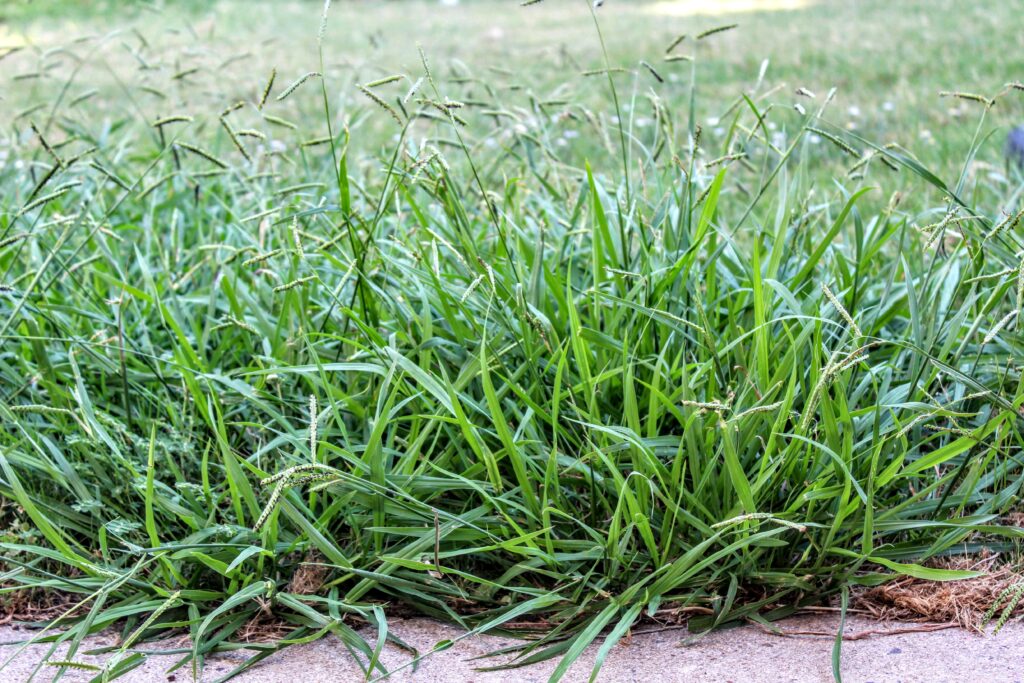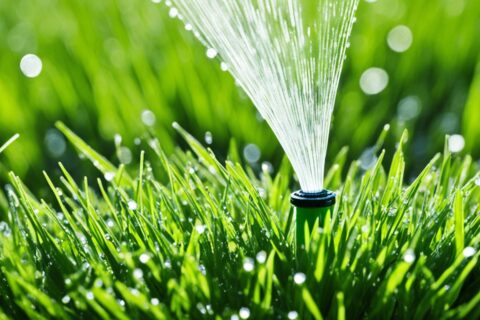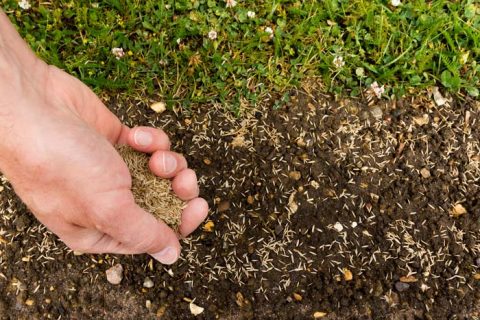When to Apply Crabgrass Pre-Emergent Herbicides: Timing and Strategy

A critical step to growing a lush, weed-free yard is knowing when to apply crabgrass pre-emergent herbicides.
Navigating that delicate balance between applying too early and too late can feel like a tightrope walk. However, with a bit of know-how, you can pinpoint the best time of year to apply pre-emergent herbicides. And here’s a hint: It’s all in the soil’s story — its temperature to be exact.
Understanding Crabgrass Pre-Emergent Herbicides for Your Lawn
It can be crucial to take early action when applying crabgrass pre-emergent weed killers. But why is that? Understanding what these products are how they work will help you appreciate why timing is so crucial.
What Is a Pre-Emergent Herbicide?
A crabgrass pre emergent is essentially a chemical defense system for your lawn. It creates a barrier below the soil’s surface that prevents weed seeds from sprouting in the soil.
But pre-emergent herbicides don’t last forever. Take, for example, the chart below which comes from a product label. This particular pre-emergent with fertilizer product: Dimension 0.10% Plus Fertilizer. When used in varying amounts, this Dimension 0.10% fertilizer will last for different durations depending on ideal conditions.
| Program | #1 | Control | #2 | Control | #3 | Control |
| Use (turfgrass cut) REGION | Pre-emergence (high-cut turf) | 3-5 months of pre-emergence crabgrass control | Pre-emergence (low-cut turf) Post-emergence (high-cut turf) | 4-6 months of pre-emergence crabgrass control | Pre-emergence (low-cut turf) Post-emergence (low-cut turf) | 4-6 months of pre-emergence crabgrass control |
| North | 2.86 lb/1,000 sq ft | 4.13 lb/1,000 sq ft‡ | 5.73 lb/1,000 sq ft | |||
| Transition | 4.13 lb/1,000 sq ft | 5.73 lb/1,000 sq ft | 8.49 lb/1,000 sq ft | |||
| South | 5.73 lb/1,000 sq ft | 8.49 lb/1,000 sq ft | 11.47 lb/1,000 sq ft | |||
| Coastal South | 8.49 lb/1,000 sq ft | 11.47 lb/1,000 sq ft | 11.47 lb/1,000 sq ft** |
How Do Pre-Emergent Herbicides Work?
Think of pre-emergent herbicides as a goalkeeper in soccer. Just as the goalie prevents goals, pre-emergent herbicides prevent weed seeds from scoring a spot in your lawn. This defense system activates when you apply the weed pre emergent to the soil surface.
And, just like in soccer, it’s all about timing. The defender must be in place before seeds germinate, and fluctuations in soil temperature largely influence this.
What Are Some Variations of Pre- Emergent Herbicides?
The market offers many pre-emergent herbicide options, so it’s important to know what you’re purchasing. Some herbicides target specific weeds, while others take a broader approach. Here’s a glance:
| Herbicide Type | Target Weeds | Application Timeframe | Combo with Fertilizer |
|---|---|---|---|
| Granular | General weeds | Early Spring | Yes |
| Liquid | Crabgrass, Broadleaf | Spring/Fall | No |
| Natural | Young seedlings | Before Germination | No |
| Fertilizer Combo | Broad range | Following Mowing | Yes |
Whether you use a standalone herbicide or fertilizer with pre emergent, the goal remains the same: prevent weed growth.
Once applied, the herbicide targets and disrupts a crucial growth enzyme specific to seedlings, inhibiting their ability to sprout.
This barrier is not indefinite though; its durability depends on proper application, soil, and weather conditions. Ensuring the barrier remains intact throughout the time it germinates is the objective for ongoing pre emergence weed control.

Identifying the Right Time of Year for a Pre-Emergent Application
The timing of your pre-emergent herbicide application is a game changer in your weed control strategy. Let’s zero in on how you can determine the best moment to apply so you can get a jump start on those pesky weeds.
What Soil Temperature Should You Apply Pre-Emergent Herbicides?
Monitoring soil temperatures is the cornerstone of effective lawn care during the transition from winter to spring.
Summer annual weeds only germinate at a certain soil temperature. Consider applying pre-emergent herbicides when soil temperatures reach and remain at 55°F for four days. Around 80% of crabgrass will sprout, for example, when soil is 60-70°F.
You could also apply a second treatment at half the usual rate about 30-45 days after your first treatment in spring which can extend the period of protection and provide added assurance against a weed invasion.
What Other Indicators Are There for Application Timing?
While soil thermometers are useful, nature provides its own vibrant indicator. Aligning your spring application around when forsythias bloom can help ensure you’re ahead of weed growth, notably crabgrass.
Environmental Factors Influencing Crabgrass Germination
Several factors come into play when considering the germination of crabgrass seeds.
- Crabgrass life cycle: Crabgrass is a summer annual, which means it lives and dies in the same year. A single crabgrass plant can produce upwards of 155,000 seeds. And they don’t all germinate at once. Many of these seeds can stay viable in the soil for several years.
- Sunlight and moisture: These are perhaps the most significant environmental factors because they determine not just if but how effectively these seeds emerge as nascent weeds.
- Soil aeration: While aerating in the early spring won’t harm your lawn, it can pull weed seeds to the soil’s surface. Aeration may also breakdown the crabgrass barrier as it punctures holes.
- Other plants: The presence of competing flora also dictate the fate of seeds. A thicker lawn helps stop crabgrass by blocking sunlight and preventing new plants from growing. It also helps hold the crabgrass barrier in place.
How Soil Can Impact Pre-Emergent Herbicide Timing and Effectiveness
Pre-emergent herbicides degrade over time. Its half-life determines the length of time that it lasts in the soil, which is the time it takes for 1/2 of the chemical to degrade. And not every pre-emergent has the same half-life.
Different factors influence the half-life of a herbicide. In turn, this impacts weed germination and your ability to control weeds. Microbes will breakdown the barriers of crabgrass preventers soon after its activated.
Soil moisture is one factor that can influence a herbicide’s half life. Knowing how waterlogged soil can affect your pre-emergent application is key to having a weed-free lawn.
The Impact Waterlogged Soil Has On Pre-Emergent Herbicides
Soils become what’s called ‘anaerobic’ when they become saturated because of excessive watering or poor drainage. In other words, there’s a lack of oxygen which can be especially problematic during the growing season.
Under saturated conditions, the chemistry of pre-emergent herbicides can change. Products degrade faster and, thus, have a reduced period of effectiveness. Take a look at the chart below, as an example:
For effective pre emergent weed control, it’s crucial to take waterlogged conditions into account. Here’s what you need to know:
As noted earlier, one key to successfully preventing crabgrass lies within the soil temperature. But when the ground is waterlogged, soil temperatures can be harder to manage and predict. This might cause you to apply crabgrass preventers too soon or too late in the spring, which could make it less effective.
In saturated conditions, the soil’s natural microbial activity, which typically helps break down herbicides, slows down. Although this may initially seem beneficial in preserving the herbicide, the subsequent oxygen depletion actually promotes faster dissipation of the product. This can cut your weed prevention efforts short and may leave your lawn vulnerable to weeds.
| Soil Condition | Pre-Emergent Herbicide Efficacy | Recommended Action |
|---|---|---|
| Dry/Aerated | Optimal | Apply as per soil temp guidelines |
| Moderately Moist | Good | Monitor for proper activation |
| Waterlogged | Reduced | Consider increased application rates or additional treatments |
To mitigate the effects of saturated soils, you might need to adjust your approach. This could mean using a stronger product and pairing this with a post-emergent crabgrass strategy. It could also mean adjusting how you water your lawn.
What to Consider If Seeding After Treatment
Look at the product label and your product’s ‘active ingredient’ before you seed. Applying a pre emergent in the spring will inhibit the growth of crabgrass, but it can thwart other lawn care efforts.
For example, many pre- and post emergent herbicides can prevent or stunt the growth of grass seeds. It also doesn’t matter whether you’re applying granular pre emergents, liquid pre emergents or a spring pre emergent fertilizer. What matters is the contents of that pre emergent product.
When applying Dimension, for example, you should delay reseeding or overseeding until 12 weeks from the time of application. Tenacity provides more flexibility, but it may reduce the density of fine fescue seedlings. You should also apply it only at or right after you seed. You must avoid spraying newly germinated grass.
If you’re thinking about seeding large areas of your lawn in the spring, consider your long-term strategy and how much patience you have.
- Timing: The easiest time of year to seed large areas is in the late summer and early fall.
- Summer annual weeds: When you seed in the spring, new grass has to compete with summer annual weeds, such as crabgrass. Crabgrass not only suffocates seedlings, but also secrets is own poison that kills nearby plants.
- Application duration: Pre-emergent herbicides can stay in the soil for a number of weeks and months. We call this a ‘seed bank.’ We can’t measure a soil’s ‘seed bank,’ but we do know it can take multiple seasons to get crabgrass under control because of it.
Planning Your Weed Control Schedule for the Next Season
With the current season’s experience fresh in your memory, it’s prudent to start seasonal weed control planning.
Analyze what worked well and what required more attention. Keep meticulous records of herbicide applications, weather patterns, and your lawn’s response. These can help you create an effective weed management strategy in the future, not just for crabgrass but for many weed species.
Your trusted lawn care provider and lawn pest exterminator
We Service Areas of Norfolk and Bristol County, Massachusetts Including, Foxborough, Mansfield, Wrentham, Walpole, Plainville, Franklin, Norfolk, Sharon, North Attleborough, and Parts of Attleboro, Stoughton, Canton, Norwood, Norton and Medfield. Learn more about our Complete Lawn Care program.


